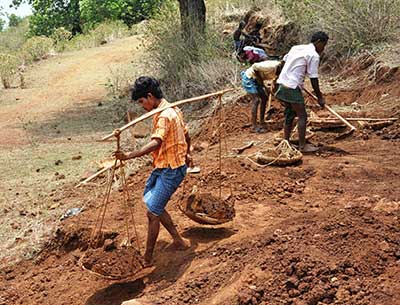Relevance: GS-2: Government policies and interventions for development in various sectors and issues arising out of their design and implementation, issues relating to poverty and hunger.
Key Phrases: Socioeconomic and Caste Census, Deendayal Antyodaya Yojana-National Rural Livelihood Mission, Sabka Saath Sabka Vikas, Social Capital of SHG, Gram Swaraj Abhiyan, Extra-Budgetary Resources, Livelihood Diversification In Rural Areas.
Why in News?
- As per a recent World Bank Report, extreme poverty in India reduced from 22.5 percent to 10.2 percent.ie., more than halved between 2011 and 2019.
- The reduction is higher in rural areas, from 26.3 percent to 11.6 percent.
- The rate of poverty decline between 2015 and 2019 was faster compared to 2011-2015.
Factors Contributing to Declining Poverty:
- Poverty has reduced significantly because of the current government’s thrust on improving the ease of living of ordinary Indians through schemes such as the Ujjwala Yojana, PM Awas Yojana, Swachh Bharat Mission, Jan Dhan, and Mission Indradhanush in addition to the Deendayal Antyodaya Yojana-National Rural Livelihood Mission and improved coverage under the National Food Security Act.
- Credit for this success can be given to all government departments, especially for their janbhagidari-based thrust on pro-poor public welfare that ensured social support for the endeavour.
Key Factors For Faster Reduction of Poverty in Rural Areas:
- Identification of Beneficiaries Based on SECC 2011:
- The identification of deprived households based on the Socioeconomic and Caste Census (SECC) 2011 across welfare programs helped in creating a constituency for the well-being of the poor, irrespective of caste, creed, or religion.
- This was critical in accomplishing the objectives of “Sabka Saath, Sabka Vikas”.
- Since deprivation was the key criterion in identifying beneficiaries, thus, SC and ST communities got higher coverage and the erstwhile backward regions in Bihar, Madhya Pradesh, Rajasthan, Uttar Pradesh, Jharkhand, Odisha, Chhattisgarh, Assam, Rajasthan, and rural Maharashtra got a larger share of the benefits.
- This came out to be a game-changer in the efforts to ensure balanced development, across groups and across regions.
- Social groups that often remained excluded from government programmes were included that too with the validation of gram sabha validation.
- Expansion of Coverage of Women Under DAY and SHG:
- The coverage of women under the DAY and SHGs has increased from 2.5 crores in 2014 to over 8 crores in 2018 as a result of more than 75 lakh SHGs working closely with over 31 lakh elected Panchayati Raj representatives, 40 percent of whom are women.
- This provided a robust framework to connect with communities and created a social capital that helped every programme.
- The PRI-SHG partnership catalysed changes that increased the pace of poverty reduction and the use of Aadhaar cleaned up corruption at several levels and ensured that the funds reached those whom it was meant for.
- Basic Infrastructure Creation:
- Finance Commission transfers were made directly to gram panchayats leading to the creation of basic infrastructure like pucca village roads and drain at a much faster pace in rural areas.
- High speed of road construction under the Pradhan Mantri Gram Sadak Yojana created greater opportunities for employment in nearby larger villages/census towns/kasbas by improving connectivity and enhancing mobility.
- Credit Availability:
- The social capital of SHGs ensured the availability of credit through banks, microfinance institutions, and MUDRA loans.
- The NRLM prioritised livelihood diversification and implemented detailed plans for credit disbursement.
- Community-led Action in Welfare Schemes’ Implementation:
- In the two phases of the Gram Swaraj Abhiyan in 2018, benefits such as gas and electricity connections, LED bulbs, accident insurance, life insurance, bank accounts and immunisation were provided to 6,3974 villages that were selected because of their high SC and ST populations.
- Universal Coverage of Schemes:
- The thrust on universal coverage for individual household latrines, LPG connections, and pucca houses ensured that no one was left behind. This created the Labarthi Varg.
- Augmenting Fund Transfer to Rural Areas:
- A high amount of public funds was transferred to rural areas, including from the share of states and, in some programmes, through extra-budgetary resources.
- Robust Community Participation:
- The thrust of a people’s plan campaign, “Sabki Yojana Sabka Vikas” for preparing the Gram Panchayat Development Plans and for ranking villages and panchayats on human development, economic activity, and infrastructure, from 2017-18 onwards, laid the foundation for robust community participation in ensuring accountability.
- Social and Concurrent Auditing:
- Processes like social and concurrent audits ensured full utilisation of resources.
- Several changes were brought about in programs like the MGNREGS to create durable and productive assets.
- This helped marginal and small farmers in improving their homesteads and diversifying their livelihoods.
- Livelihood Diversification in Rural Areas:
- The competition among states to improve performance on rural development helped. Nearly all states and UTs focussed on improving livelihood diversification in rural areas and on improving infrastructure significantly.
Conclusion:
- All these factors contributed to improving the ease of living of deprived households and improving their asset base.
- A lot has been achieved, but much remains to be done.
- However, the pandemic and the negative terms of trade shock from the Ukraine crisis pose challenges to the gains made in poverty reduction up to 2019.
Source: The Indian Express
Mains Question:
Q. Extreme poverty in India is more than halved between 2011 and 2019 as per a recent World Bank Report. Explain the key factors responsible for the decline in rural poverty. (250 words).







